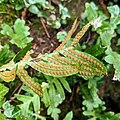Sporangium
Sporangium is a single-celled or multi-cellular structure in which spores are produced. It is found in fungi, algae, and some plants. The term "sporangium" is derived from the Latin words "spora" meaning "seed", and "angium" meaning "vessel".
Structure and Function[edit]
Sporangia are typically single-celled or multi-cellular structures that are responsible for the production of spores. They are found in a wide variety of organisms, including fungi, algae, and some plants. The structure of the sporangium can vary greatly depending on the organism in which it is found. In fungi, for example, the sporangium is often a complex structure that includes a stalk and a cap. In plants, the sporangium is typically a simple structure that is attached to the plant's stem or leaves.
The primary function of the sporangium is to produce and release spores. These spores can then be dispersed by a variety of mechanisms, including wind, water, or animals. Once the spores have been dispersed, they can germinate and grow into new organisms.
Types of Sporangia[edit]
There are several different types of sporangia, including:
- Zygosporangium: This type of sporangium is found in zygomycetes, a group of fungi. It is formed from the fusion of two different types of hyphae, and it produces zygospores.
- Oogonium: This is a type of sporangium found in certain types of algae and fungi. It produces oospores.
- Ascus: This type of sporangium is found in ascomycetes, a group of fungi. It produces ascospores.
- Basidium: This type of sporangium is found in basidiomycetes, a group of fungi. It produces basidiospores.
See Also[edit]
Ad. Transform your life with W8MD's Budget GLP-1 injections from $75


W8MD offers a medical weight loss program to lose weight in Philadelphia. Our physician-supervised medical weight loss provides:
- Weight loss injections in NYC (generic and brand names):
- Zepbound / Mounjaro, Wegovy / Ozempic, Saxenda
- Most insurances accepted or discounted self-pay rates. We will obtain insurance prior authorizations if needed.
- Generic GLP1 weight loss injections from $75 for the starting dose.
- Also offer prescription weight loss medications including Phentermine, Qsymia, Diethylpropion, Contrave etc.
NYC weight loss doctor appointmentsNYC weight loss doctor appointments
Start your NYC weight loss journey today at our NYC medical weight loss and Philadelphia medical weight loss clinics.
- Call 718-946-5500 to lose weight in NYC or for medical weight loss in Philadelphia 215-676-2334.
- Tags:NYC medical weight loss, Philadelphia lose weight Zepbound NYC, Budget GLP1 weight loss injections, Wegovy Philadelphia, Wegovy NYC, Philadelphia medical weight loss, Brookly weight loss and Wegovy NYC
|
WikiMD's Wellness Encyclopedia |
| Let Food Be Thy Medicine Medicine Thy Food - Hippocrates |
Medical Disclaimer: WikiMD is not a substitute for professional medical advice. The information on WikiMD is provided as an information resource only, may be incorrect, outdated or misleading, and is not to be used or relied on for any diagnostic or treatment purposes. Please consult your health care provider before making any healthcare decisions or for guidance about a specific medical condition. WikiMD expressly disclaims responsibility, and shall have no liability, for any damages, loss, injury, or liability whatsoever suffered as a result of your reliance on the information contained in this site. By visiting this site you agree to the foregoing terms and conditions, which may from time to time be changed or supplemented by WikiMD. If you do not agree to the foregoing terms and conditions, you should not enter or use this site. See full disclaimer.
Credits:Most images are courtesy of Wikimedia commons, and templates, categories Wikipedia, licensed under CC BY SA or similar.
Translate this page: - East Asian
中文,
日本,
한국어,
South Asian
हिन्दी,
தமிழ்,
తెలుగు,
Urdu,
ಕನ್ನಡ,
Southeast Asian
Indonesian,
Vietnamese,
Thai,
မြန်မာဘာသာ,
বাংলা
European
español,
Deutsch,
français,
Greek,
português do Brasil,
polski,
română,
русский,
Nederlands,
norsk,
svenska,
suomi,
Italian
Middle Eastern & African
عربى,
Turkish,
Persian,
Hebrew,
Afrikaans,
isiZulu,
Kiswahili,
Other
Bulgarian,
Hungarian,
Czech,
Swedish,
മലയാളം,
मराठी,
ਪੰਜਾਬੀ,
ગુજરાતી,
Portuguese,
Ukrainian









